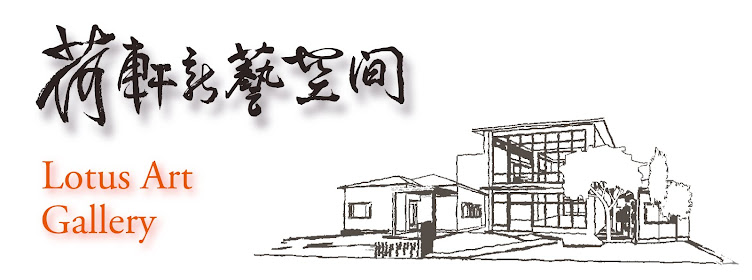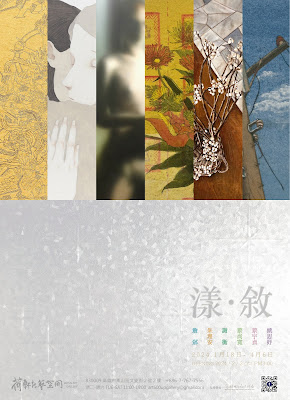展出藝術家
莊普、黃銘哲、盧明德、曲德義、梅丁衍
山海線意味著台灣交通命脈-縱貫線,五位年屆耳順之年的藝術家北至宜蘭的黃銘哲,南至高雄的盧明德,和台北的莊普、曲德義、梅丁衍,在藝術崗位上奮鬥不懈,形成一條隱形的藝術縱貫線。他們之間有濃厚的友誼,雖然分居在山海線上,有南北的距離,但堅持藝術的心則是零距離。
展期 4/26~5/26
縱貫線上五路英雄
山海線意味著台灣交通命脈-縱貫線,五位年屆耳順之年的藝術家北至宜蘭的黃銘哲,南至高雄的盧明德,和台北的莊普、曲德義、梅丁衍,在藝術崗位上奮鬥不懈,形成一條隱形的藝術縱貫線。他們之間有濃厚的友誼,雖然分居在山海線上,有南北的距離,但堅持藝術的心則是零距離。
這五位畫家代表台灣美術史上的一個切面,八〇年代當代藝術興起的狂飆年代,因為一九八六年台灣解嚴,新聞與集會有更寬廣的空間,藝術家在形式上內容上更自由表達,台灣社會經濟起飛,人民的視野見聞增廣,對於事物有獨立的思考空間,諸多的因素使台灣當代藝術表現多元且蓬勃,如同社會中充滿活力與創造力。
時代切面甘苦與共
約在此時生於上海,1973至1978在西班牙馬德里大學藝術學院深造的莊普展露頭角,生於1948年宜蘭冬山的黃銘哲,結束1976到1980 的歐美遊學生活返鄉居台北頻頻得獎,1949年出生於高雄,台灣師範大學美術系畢業的盧明德,在日本停留10年後,1984年自日本筑波藝術研究所畢業,到台中東海大學任教,數年後再到高雄師範大學任教至今。曲德義於1952年出生韓國井邑,也畢業於台灣師範大學美術系,1983年就讀法國國立高等設計學院,隔年自法國國立高等美術學院畢業返回台灣,任教關渡台北藝術大學迄今,梅丁衍1954年出生於台北,文化大學美術系畢業,1985自紐約普拉特學院(Pratt Institute)畢業返台,目前任教國立台灣藝術大學,回國恭逢台灣政治局勢的改變,促使他以政治議題為軸創作。
五位藝術家出生在不同的地區,但藝術的基礎則奠定於台北,之後他們分別於西班牙、美國、日本、法國進修,帶回多元的創作理念與藝術思潮回國,又因為他們當中多有擔任教職,承擔培育下一代藝術種子的重任,在創作與教學的兩條路上相互切磋砥礪,深感人生路上相知相契因緣可貴,故藉此次展覽回首來時路,溫故知新分享大眾。
藝術家的成長撞擊需要藝術環境培育,台灣當時除了公立的美術館與私人畫廊,還有蓬勃的藝術活動,他們有的相識於畫廊博覽會,有的交遊於自主性的藝術演示空間-伊通公園,並且多與藝術行政相關人員與藝術批評專家學者有所往來激盪。三十年來一起成長,對藝術無悔付出,如今也各據山海一方。這當中經歷藝術市場的興衰,面臨海峽兩岸發展的爭議,尋找亞州藝術的切入點,研討藝術教育的方向,最終都有對應之道,而且各自有成。
各懷絕技自在自若
時間的推移,成就畫家的創作成果,五人交情深厚,藝術各有堅持。
黃銘哲出生農家,90年代以都會女人為題創作,後來將半抽象繪畫轉為立體造型的抽象結構,風格從未定型,北市街頭中其公共藝術作搶眼獨特。
盧明德從1980年代以複合媒體觀念創作至今,持續將龐大的圖像語言符號,重組排列相接對話,成為跨領域跨媒體的表現形式,並走向群體共榮的理想境地。
莊普向來以詩意的手法表達理性構成的繪畫,近期的印格繪畫已拓展至空間的裝置藝術,純粹的抽象形式隱藏著無法詮釋的結構與空間。
曲德義重視作品形式本身,對作品的細節深入分析解構,所以繪畫材料的物質性成為其藝術表現語言,他在色域中使用不同彩度與留白方格所形成格柵,構築靜態中有律動的抽象繪畫。
梅丁衍以創作政治性藝術著稱,針對政治形態圖騰進行反諷,一種強烈的歷史感與自我認同的追求,促使他不斷藉由歷史照片懷舊文物等現成物與數位影像來呈現他的反思。
展覽發起者盧明德說:「現在年歲到了六十,只有一種心情,做自己愛做的事。」,黃銘哲說:「藝術到我這年紀,再不做什麼,很快就不能做什麼。」,他們的創作自若自在,將身心靈融入繪畫,所以今日的展覽不在乎風格理念的異同,而是以心境的交流來看待。期待前來的觀賞者,除了回味五位藝術家所有的豐碩成果,也有同樣的心情分享這五位畫家生命的成長與藝術歷程。
藝術家簡歷
BY Sharon H L Pai
Five heroes on the north-south art line
The mountain-coastal lines refer to Taiwan's transportation artery - the North-South Line. The five artists aged around sixty, including Huang Ming-Che born in Yilan, Lu Ming-Te based in Kaohsiung, and Tsong Pu, Chu Teh-I, and Mei Dean-E settled in Taipei, have strived for art unremittingly in their positions, forming an invisible north-south art line from Yilan to Kaohsiung. They remain a close and deep friendship with one another. In spite of their different geographical locations on the mountain-coastal lines, there is no distance among their strong commitments to art.
The five artists represent a turning point in Taiwan’s history of fine arts – the rapid and dramatic rise of contemporary art in the 1980s. More specifically, the lifting of martial law in 1987 allowed more freedom of assembly and freedom of the press, enabling artists to create their artworks more freely in terms of form and content. Also, while the economy of Taiwan was booming, easier access to information and knowledge facilitated people’s critical thinking. A variety of factors contributed to the diversity and prosperity of contemporary art practice in Taiwan as well as social vitality and creativity.
Sharing prosperity and adversity in the same era
Around the same time, Tsong Pu, who was born in Shanghai and studied at University Complutense de Madrid, Spain between 1973 and 1978, emerged as a budding artist. Huang Ming-Che, who was born in Dongshan Township, Yilan County in 1948 and studied in Europe and America between 1976 and 1980, returned to Taiwan and stayed in Taipei as a high-profile award-winning artist. Born in Kaohsiung in 1950 and obtaining a BA in Fine Arts, National Taiwan Normal University, Lu Ming-Te went to stay in Japan for five years and completed the master’s program in fine art, the University of Tsukuba in 1984. After several years of teaching at Tunghai University, he secured a teaching position at National Kaohsiung Normal University and remains there until now. Chu Teh-I, born in Jeongeup, Korea and earning his BA in Fine Arts, National Taiwan Normal University, went to study at L'Ecole Nationale Supérieure Des Arts-Decoratifs De Paris, France in 1983. The following year he graduated from L'Ecole Nationale Supérieure Des Beaux-Arts De Paris, France and returned to Taiwan. He has taught at Taipei National University of the Arts ever since. Mei Dean-E, born in Taipei in 1954 and holding a BA in Fine Arts, the Chinese Culture University, finished his study at Pratt Institute, New York and returned to Taiwan in 1985. Experiencing the change of Taiwan's political landscape upon his return prompted Mei to create his artworks around political issues. At present, he teaches at National Taiwan University of Arts as a professor.
In spite of the difference in their birthplaces, all of the five artists developed their artistic foundations in Taipei. After finishing advanced art studies in Spain, America, Japan, or France, they returned home with diverse artistic philosophies and knowledge of ideological trends in art. While most of them shoulder the responsibility as art educators for developing next-generation artistic talent, the exchange of ideas and inspirations among them on the tracks of creation and teaching has never stopped. Their lasting friendship and good rapport with one another, which are comparatively rare and precious, now prompt them to share their artworks, both past and present, with the public through this joint exhibition.
Inspiring and constructive encounters between artists are usually facilitated in a thriving environment for the arts. In addition to public fine arts museums and private galleries, a variety of arts events were also available at the time in Taiwan. Some of the five artists got acquainted with one other at gallery exhibitions, while the others were connected and gathered in IT PARK, a venue for independent art exhibitions, and have developed frequent contacts with those working in arts administration and management as well as critics, experts, and scholars in art circles. For the past three decades, they have grown together and thrown themselves into the art world without regret or reservation. Now they each have achieved prominence in different corners of Taiwan. On their career journey, they experienced the ebb and flow of the art market, witnessed the controversy about the development of the cross-strait relations, sought breakthroughs in demonstrating Asian art, and explored the directions for art education. Whatever problems arose, they each found solutions and achieved success.
Exceptional artistic talent displayed at ease
With the passage of time, the five artists have produced distinctive creations on different tracks while remaining a close and deep friendship with one another.
Huang Ming-Che, born into a farmer’s family, created his works around a theme of women in cities in the 1990s. Afterwards, he shifted his creation focus from semi-abstract paintings to cubic abstract sculpture in various styles. His eye-catching and unique public art works have stood out on Taipei city streets.
Lu Ming-Te, who has engaged in creating mixed-media artworks since the 1980s, continues to produce art dialogue by arranging and rearranging huge iconic signs in interdisciplinary and cross-media expressive styles and proceed toward his utopia where all arts and media enjoy common prosperity.
Tsong Pu, whose rationalistic paintings have been created in a poetic style, has made his creation focus extend from pattern paintings to installations, with uninterpretable structure and space hidden in pure abstraction.
Chu Teh-I puts emphasis on form and presents the details of his artworks through analysis and deconstruction. Therefore, the properties of painting materials become the language which he uses to express art. With crisscross patterns created through colorfulness changes and empty spaces, his abstract paintings feature dynamics within static composition.
Mei Dean-E is noted for his political artworks, in which he deals with political images sarcastically. Driven by a strong sense of history and a desire to seek his self-identity, Mei constantly presents his critical thinking by using ready-made historical photos or relics and digital images.
Lu Ming-Te, the initiator of this exhibition, said, “My only thought in my sixties is that I should do what delights me.” Huang Ming-Che said, “In light of my old age, I need to do more about art before it’s too late.” The five artists have produced their artworks at ease and integrated them with their body, mind, and spirit. Therefore, one should seek spiritual exchanges with the artworks in this exhibition regardless of the difference and similarity in the artistic styles and philosophies. It is hoped that visitors to this exhibition may develop identification with the personal growth and art career history of the five artists while enjoying the retrospective of their fruitful and prolific output of art.

-01.jpg)



沒有留言:
張貼留言